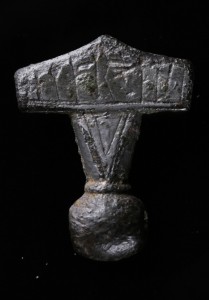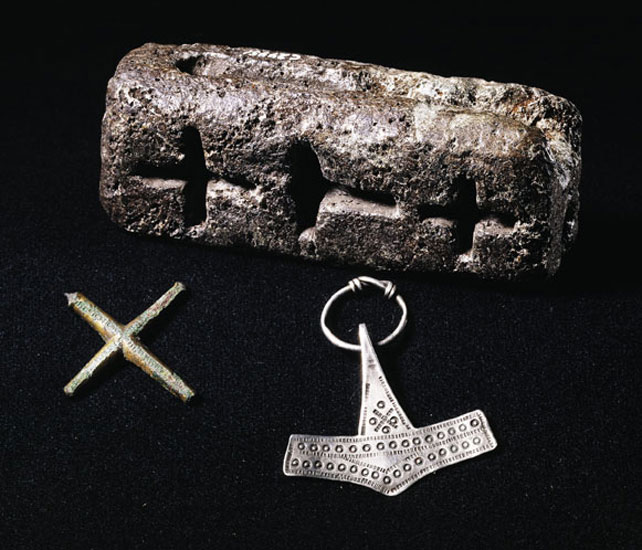‘This is a hammer’ says the Runic inscription on an amulet, which an unknown Viking lost on one of the small islands in Southern Denmark.
Thor’s hammers are not rare. Approximately a 1000 are known from Scandinavia, Russia, Great Britain and the Baltics, with a certain concentration in present- day Denmark and Southern Sweden. Found in graves, hoards or just as chance finds, they tend to crop up in many contexts in the 10th century. The pendants are made of iron, lead, bronze, silver and even gold.
However the latest is unique, in so far as it contains an inscription – ‘Hmar x is’ = hammer is, explains Lisbet Imer from the National Museum in Copenhagen (the ‘x’ is a sign, intended to mark a division between the two words).

The runologist explains that the runes are normal Viking runes, but that the S-rune is laterally reversed. She believes that the rune carver was not very skilled, since he (or she) also forgot to carve the vocal ‘a’.
The archaeologist Peter Pentz, is very pleased with the new find, which measure no more than 2.5 cm: “It vindicates the small hammers for what they are: hammers”, he says.
For some time it has been fashionable amongst certain medievalists to believe that the amulets were not witnesses to the pagan worship of the god Thor. Some have claimed that the shafts were too short, others that hammers from the 10th century were not double-edged. The is important because if the amulets were not hammers they could not be understood as part of or symbol of a pagan reaction in the 10th century, as was for a long time the consensus amongst Viking historians.
According to the exited curators at the National Museum in Copenhagen the hammers have now been vindicated as exactly what they were always believed to be: Thor’s Hammers.
This also fits with the chronological overview presented by the archaeologist, Jörn Stäcker. According to him, these pagan symbols were substituted by crosses around AD 1000 in Denmark, between AD 950 – 1000 in Sweden and around AD 1100 on the Island of Gotland in the Baltic. Another interesting feature about the hammers are that they have predominantly been found in female graves.
SOURCE:
The Cross Goes North: Christian Symbols and Scandinavian Women.
By Jörn Stäcker
In: The Cross goes North. Processes of Conversion in Northern Europe AD 300 – 1300. Ed. By Martin Carver, The Boydell Press 2003, pp. 463 – 483.
Thor-kult i vikingetiden- historiske studier i vikingetidens religion
By Lasse Sonne
Copenhagen, Museum Tusculanums Forlag 2013
A review in Danish of the recent scholarly debates caused by the work of Lasse Sonne
